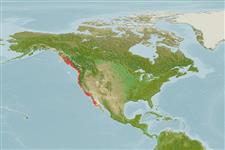Environment: milieu / climate zone / depth range / distribution range
Ekologi
marina bottenlevande; djupintervall 0 - 200 m (Ref. 2850). Subtropical; 58°N - 26°N, 137°W - 112°W
Eastern Pacific: Sitka, southeastern Alaska to Punta Abrejos, central Baja California, Mexico.
Size / Vikt / Age
Maturity: Lm ? range ? - ? cm
Max length : 99.0 cm TL hane/ej könsbestämd; (Ref. 2850); publicerad maxvikt: 14.0 kg (Ref. 27436); rapporterad maxålder: 13 år (Ref. 56049)
Short description
Bestämningsnycklar | Morfologi | Morfometri
Taggstrålar i ryggfenan (totalt) : 8 - 12; Mjukstrålar i ryggfenan (totalt) : 15 - 18; Taggstrålar i analfenan: 0; Mjukstrålar i analfenan: 11 - 13; Ryggkotor: 35. Caudal fin barely rounded.
Inhabits rocky, sandy and muddy bottoms as well as kelp beds (Ref. 4925). Adults and juveniles feed on crustaceans, fishes and mollusks (Ref. 6885). Commonly captured by sport fishers (from shore, boats or piers) and by scuba divers (Ref. 2850). Flesh is good eating but eggs are poisonous and will make humans violently ill (Ref. 13513).
Eschmeyer, W.N., E.S. Herald and H. Hammann, 1983. A field guide to Pacific coast fishes of North America. Boston (MA, USA): Houghton Mifflin Company. xii+336 p. (Ref. 2850)
IUCN Red List Status (Ref. 130435: Version 2024-1)
Human uses
Fiskeri: kommersiell; sportfisk: ja; Akvarium: Offentliga akvarier
Verktyg
Special reports
Download XML
Internet-källor
Estimates based on models
Preferred temperature (Ref.
123201): 7.5 - 11.6, mean 8.9 °C (based on 40 cells).
Phylogenetic diversity index (Ref.
82804): PD
50 = 1.0000 [Uniqueness, from 0.5 = low to 2.0 = high].
Bayesian length-weight: a=0.00389 (0.00180 - 0.00842), b=3.12 (2.94 - 3.30), in cm total length, based on all LWR estimates for this body shape (Ref.
93245).
Trofisk nivå (Ref.
69278): 3.6 ±0.47 se; based on food items.
Generation time: 3.2 ( na - na) years. Estimated as median ln(3)/K based on 1
growth studies.
Resiliens (Ref.
120179): Mellan, lägsta populationsfördubblingstid 1,4-4,4 år (tm=3; tmax=13; K=0.3, Fec=40,000-90,000).
Prior r = 0.33, 95% CL = 0.22 - 0.50, Based on 4 full stock assessments.
Fishing Vulnerability (Ref.
59153): Moderate vulnerability (37 of 100).
Climate Vulnerability (Ref.
125649): Moderate vulnerability (44 of 100).
Nutrients (Ref.
124155): Calcium = 75.8 [30.9, 167.0] mg/100g; Iron = 0.974 [0.431, 2.041] mg/100g; Protein = 18.4 [16.2, 20.5] %; Omega3 = 0.314 [0.140, 0.892] g/100g; Selenium = 48.9 [24.8, 117.3] μg/100g; VitaminA = 6.13 [2.10, 17.38] μg/100g; Zinc = 0.592 [0.387, 0.936] mg/100g (wet weight);
